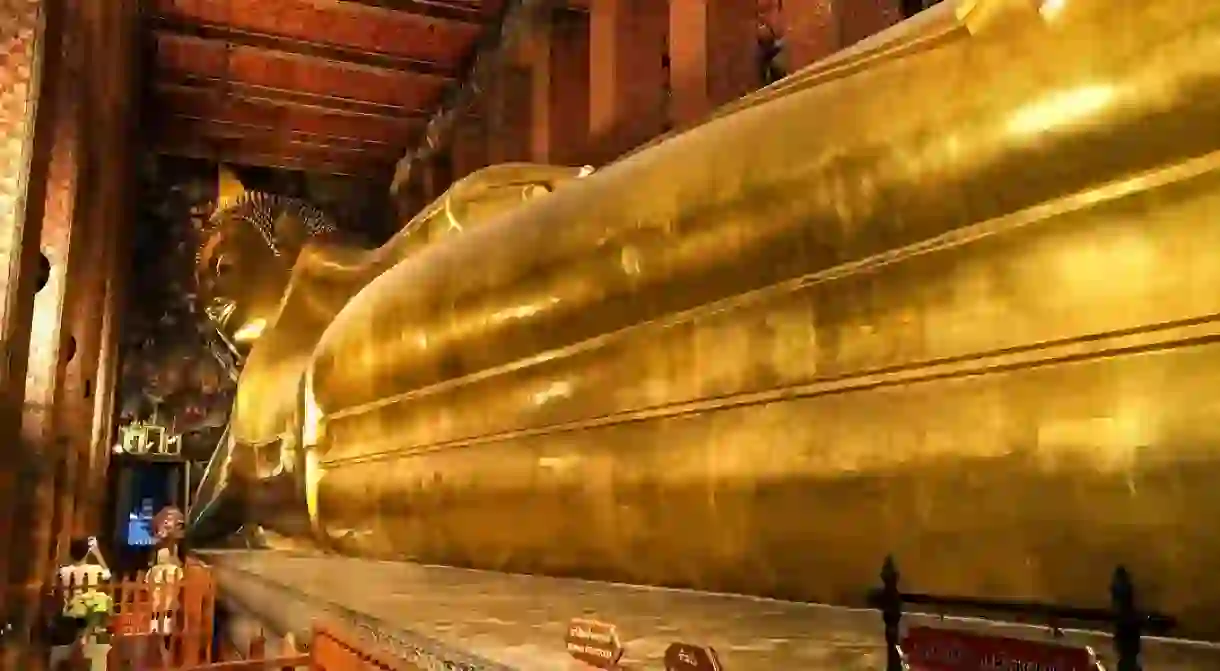The 12 Most Beautiful Buddhist Artworks

One of the most recognizable images within Buddhist art is that of the figure of the Buddha himself. Statues of the Buddha have always been historically important artistic, religious, and social symbols. These 12 sculptures of the Buddha, both historical and contemporary, are especially worth meditating on.
Daibutsu at Tōdai-ji
Located at the Buddhist temple Tōdai-ji in Nara, Japan, this sculpture is the world’s largest bronze statue of the Buddha, its height reaching nearly 15 meters. The Buddha’s head is adorned with 960 individual six curls. Recently, relics including jewelry and human teeth were found inside the statue, and have been attributed to Emperor Shomu.

Grand Buddha at Ling Shan
This enormous representation of the Buddha in China‘s Jiangsu Province is made of bronze and weighs over 700 tons. At 88 meters tall, the figure is an awesome sight, especially when surrounded by fog. This sculpture is one of the youngest on this list, as it was completed in 1996. The sculpture is situated close to Xiangfu Temple, near Lake Taihu and the rolling hills behind it.

Leshan Giant Buddha
Located in Sichuan Province in China, the Leshan Giant Buddha is a seated figure carved into a red rock cliff face. At 77 meters tall, it is the largest stone statue in the world. Work on the giant stone statue was begun in 713 AD and finished in 803 AD. It was constructed at the juncture of three rivers in hopes that the depiction of the Buddha would tame the dangerous currents downstream.

Monywa Buddha
The largest statue of a reclining Buddha in the world, the Monywa Buddha can be found in Monywa, Myanmar. Measuring over 90 meters in length, the sculpture is hollow, and visitors can venture inside its gold and white exterior. The reclining pose of the figure signifies the Buddha’s death and passing into nirvana. Constructed in 1991, this representation of the Buddha is one of the youngest on this list.

Phutthamonthon Buddha
Located in the Nakhom Pathom district of Thailand, the Phutthamonthon Buddha was made by Corrado Feroci, an Italian-born artist who is attributed with bringing modern art to Thailand’s universities. The sculpture is the highest free-standing depiction of the Buddha in the world. Buddha is seen standing with an arm outstretched, and four sites surrounding the base of the sculpture recall the Buddha’s birth, enlightenment, first sermon, and death.

Tian Tan Buddha Statue
The Tian Tan Buddha was constructed in 1993 and is located in Hong Kong. It is surrounded by smaller statues with offerings to the Buddha that represent generosity, morality, patience, zeal, meditation, and wisdom. Made from bronze with a steel frame, the sculpture is 34 meters tall and weighs 250 tons. Visitors climb 268 stairs to reach the base of the enormous statue. The Buddha sits with his right hand facing the sky, gesturing the removal of affliction, and his left hand rests on his lap with its palm facing upward, signaling his generosity.

Buddha Statue of Hyderabad
Located in Telengana India, the Buddha of Hyderabad is made of solid white granite. Inspired by the Statue of Liberty, N.T. Rama Rao commissioned the giant Buddha, which now stands on a pedestal in lake Hussain Sagar. The Buddha wears cloth robes and one hand is raised, its palm facing forward. The sculpture was constructed between 1985 and 1990. In efforts to erect the statue, ten people were killed when it fell sideways into the lake on which it sits. Later, the Dalai Lama blessed the site and sculpture.

Ayutthaya Buddha Head
An image that embodies Buddhism’s relationship to nature, the Ayutthaya Buddha is also a marker of Buddhist history. Once part of a temple that was destroyed in 1767 when the Burmese army invaded Ayutthaya, the head is now enveloped in the roots of a large tree. The position of the Buddha head in the tree calls to mind the symbol of the Bodhi tree, where Siddartha Gautama attained enlightenment.

Gal Vihara
Gal Vihara is a temple constructed in the 12th century with carved rock relief sculptures. It is located in the North Central Province of Sri Lanka. The granite sculptures depict a seated, standing, and reclining Buddha, and are considered some of the most important examples of ancient Sinhalese art. Each image was carved to fit the dimensions of each rock face, and each relief carving is five meters deep.

Wat Pho
Also known as the Temple of the Reclining Buddha, Wat Pho is a temple in Bangkok, Thailand, dating from the 16th century. The sculpture of the reclining Buddha refers to Buddha’s attainment of enlightenment, and the figure’s posture is traditionally likened to a sleeping lion. The statue is made primarily from brick and plaster, and is adorned with gold and inlays of mother-of-pearl.

Temple of the Emerald Buddha
The Emerald Buddha is only 66 centimeters tall, but is an important national treasure in Thailand. Carved from jade, the Buddha figurine dates from before the 14th century. The Buddha is seated in meditating posture and is clothed in gold robes. Now housed at the temple at the Grand Palace, the King of Thailand himself is tasked with seasonally changing the Buddha’s gold clothing.

Great Buddha of Kamakura
The enormous bronze statue of the seated Buddha at Kōtoku-in temple in Kamakura, Japan is one of the country’s most recognized symbols. Made during the 13th century, the sculpture depicts the Buddha in the lotus position, with legs folded and hands just touching while resting on his lap. The statue is hollow, and visitors can view the interior, now filled with graffiti.














